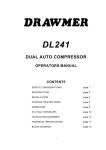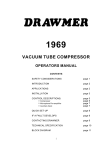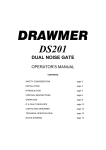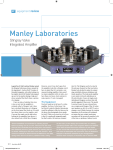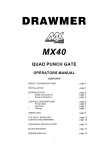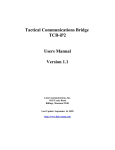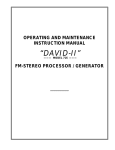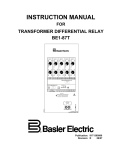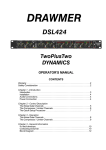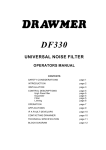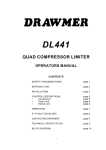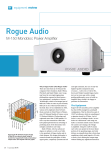Download Drawmer 1961 Specifications
Transcript
1961 VACUUM TUBE EQUALISER OPERATORS MANUAL CONTENTS SAFETY CONSIDERATIONS POWER CONNECTION INSTALLATION FUSES INTRODUCTION APPLICATIONS CONTROL DESCRIPTIONS OPERATION IF A FAULT DEVELOPS CONTACTING DRAWMER TECHNICAL SPECIFICATION BLOCK DIAGRAM i page page page page page page page page page page page page 1 2 2 3 4 5 5 7 10 10 11 12 COPYRIGHT This manual is copyrighted © 1995 by Drawmer Electronics, Ltd. With all rights reserved. Under copyright laws, this manual may not be duplicated in whole or in part without the written consent of Drawmer. ONE YEAR LIMITED WARRANTY Drawmer Electronics Ltd., warrants the Drawmer 1961 audio processor to conform substantially to the specifications of this manual for a period of one year from the original date of purchase when used in accordance with the specifications detailed in this manual. In the case of a valid warranty claim, your sole and exclusive remedy and Drawmer’s entire liability under any theory of liability will be to, at Drawmer’s discretion, repair or replace the product without charge, or, if not possible, to refund the purchase price to you. This warranty is not transferable. It applies only to the original purchaser of the product. For warranty service please call your local Drawmer dealer. Alternatively call Drawmer Electronics Ltd. at +44 (0)1709 527574. Then ship the defective product, with transportation and insurance charges pre-paid, to Drawmer Electronics Ltd., Coleman Street, Parkgate, Rotherham, S62 6EL UK. Write the RA number in large letters in a prominent position on the shipping box. Enclose your name, address, telephone number, copy of the original sales invoice and a detailed description of the problem. Drawmer will not accept responsibility for loss or damage during transit. This warranty is void if the product has been damaged by misuse, modification or unauthorised repair. THIS WARRANTY IS IN LIEU OF ALL WARRANTIES, WHETHER ORAL OR WRITTEN, EXPRESSED, IMPLIED OR STATUTORY. DRAWMER MAKES NO OTHER WARRANTY EITHER EXPRESS OR IMPLIED, INCLUDING, WITHOUT LIMITATION, ANY IMPLIED WARRANTIES OF MERCHANTABILITY, FITNESS FOR A PARTICULAR PURPOSE, OR NON-INFRINGEMENT. PURCHASER’S SOLE AND EXCLUSIVE REMEDY UNDER THIS WARRANTY SHALL BE REPAIR OR REPLACEMENT AS SPECIFIED HEREIN. IN NO EVENT WILL DRAWMER ELECTRONICS LTD. BE LIABLE FOR ANY DIRECT, INDIRECT, SPECIAL, INCIDENTAL OR CONSEQUENTIAL DAMAGES RESULTING FROM ANY DEFECT IN THE PRODUCT, INCLUDING LOST PROFITS, DAMAGE TO PROPERTY, AND, TO THE EXTENT PERMITTED BY LAW, DAMAGE FOR PERSONAL INJURY, EVEN IF DRAWMER HAS BEEN ADVISED OF THE POSSIBILITY OF SUCH DAMAGES. Some states and specific countries do not allow the exclusion of implied warranties or limitations on how long an implied warranty may last, so the above limitations may not apply to you. This warranty gives you specific legal rights. You may have additional rights that vary from state to state, and country to country. In the interests of product development, Drawmer reserve the right to modify or improve specifications of this product at any time, without prior notice. ii 1961 OPERATORS’ MANUAL 1 DRAWMER 1961 VACUUM TUBE EQUALISER SAFETY CONSIDERATIONS CAUTION - MAINS FUSE TO REDUCE THE RISK OF FIRE REPLACE THE MAINS FUSE ONLY WITH A FUSE THAT CONFORMS TO IEC 127-2. 250 VOLT WORKING, TIME DELAY TYPE WITH A BODY SIZE OF 20mm x 5mm. THE MAINS INPUT FUSE MUST BE RATED AT 250mA WHERE THE MAINS INPUT VOLTAGE SWITCH IS SET TO 230 VOLTS AC. AND 500mA WHERE THE MAINS INPUT VOLTAGE IS 115 VOLTS AC. THE REAR PANEL H.T. FUSE MUST ALWAYS BE RATED AT 50mA, IRRESPECTIVE OF THE MAINS VOLTAGE SETTING. CAUTION - MAINS CABLE DO NOT ATTEMPT TO CHANGE OR TAMPER WITH THE SUPPLIED MAINS CABLE. CAUTION - SERVICING DO NOT PERFORM ANY SERVICING. REFER ALL SERVICING TO QUALIFIED SERVICE PERSONNEL. WARNING TO REDUCE THE RISK OF FIRE OR ELECTRIC SHOCK DO NOT EXPOSE THIS EQUIPMENT TO RAIN OR MOISTURE. 2 1961 OPERATORS’ MANUAL POWER CONNECTION The unit will have been supplied with a power cable suitable for domestic power outlets in your country. For your own safety it is important that you use this cable. The unit should always be connected to the mains supply earth using this cable. If for some reason the unit is to be used at a mains input operating voltage which is different to that as supplied, the following procedure must be carried out. (See following diagram) 1: Disconnect the unit from the mains. 2: Using a number 1 size pozidrive screwdriver, remove the two self-tapping screws holding the voltage selection switch cover plate on the rear panel. 3: Remove the cover plate and slide the switch fully to its opposite end. 4: Rotate the cover plate one half turn, (180E) and refit the two screws. 5: Fit a correctly rated fuse for the selected operation voltage. 6: Reconnect to mains power source. INSTALLATION The 1961 is designed for standard 19" rack mounting and occupies 2U of rack space. Fibre or plastic washers may be used to prevent the front panel becoming marked by the mounting bolts. Because the tube circuitry generates more heat than an equivalent solid-state design, we recommend space be left above the unit to allow the heat to dissipate. ! Care should be taken in the choice of positioning. The unit should not be mounted where other equipment obstructs the normal air flow. The unit should not be situated near any heat source, such as a radiator, stove or a high power amplifier that would generate heat. ! The appliance should not be operated near any water or in a location where moisture might be present. ! Always connect the mains earth to the unit. If the 1961 is to be continuously moved from one location to another, we suggest using additional support in the rack at the rear of the unit. 1961 OPERATORS’ MANUAL 3 FUSES The mains fuse should be a class 3, 250 Volt, Time delay type, with a body size of 20mm x 5mm, at the correct rating for the mains input voltage. It is very important that this fuse complies with IEC127-2. Remember that, in the unlikely event of the unit developing a fault, it is normal for the mains fuse to blow and the unit must be serviced by a qualified service technician. For added protection the 1961 is also fitted with silicon re-setable fuses. Under certain conditions, - eg. intermittent mains power, faulty mains cable - these fuses will 'trip', effectively removing power from the internal circuitry. If this should happen, the silicon fuses will automatically reset after switching off the unit for 15 to 30 seconds and then switching back on again. The fuses will probably never trip. Occasionally the fuses might trip repetitively due to an internal fault, in which case the unit will need attention from a service technician before the silicon fuses will reset. AUDIO CONNECTIONS The inputs and outputs are electronically balanced XLRs where pin 1 is screen, pin 2 hot, pin 3 cold and the XLR shell is connected to chassis. The operating level is nominally +4dBu. Balanced use is recommended. The 1961 fully conforms to the EMC standards, if you propose to use the unit where it maybe exposed to high levels of disturbance such as found close to TV and radio transmitters we suggest that the screen of the signal cable is connected to the chassis connection on the XLR type connector. A further connection point is provided in the form of the Audio Insert jack on the rear panel. This is a stereo jack socket wired such that the Ring carries the input to the 1961 and the Tip carries the output. W hen a plug is inserted, the XLR input for that channel is disconnected. The Audio Insert point may be connected directly to the side-chain access point of a Drawmer 1960 using a stereo jack cable wired with screened cable where the tip connects to the tip; ring connects to ring and the screen is connected at both ends. Alternatively, the same type of stereo jack lead may be used to connect the 1961 Audio Inserts to the +4dBU Signal Insert point of the 1960 allowing the two units to be used in series. In this latter configuration, only the balanced audio connections of the 1960 are used; the 1961 is connected only via its Audio insert points. If earth loop problems are encountered, do not disconnect the mains earth. Try disconnecting the signal screen on one of the cables connecting the outputs of the 1961 to the patchbay. If such measures are necessary, balanced operation is recommended. 4 1961 OPERATORS’ MANUAL INTRODUCTION The Drawmer 1961 is a hybrid, vacuum tube/semi-conductor, dual-channel equaliser designed to combine the tonal qualities of classic tube circuitry with the low noise and high reliability associated with contemporary circuit design. A simple linking facility is included which allows the 1961 to be used in conjunction with the Drawmer 1960 tube compressor/preamplifier where it may be used either in the side-chain ( for de-essing, de-popping and so forth ) or in the main signal path for conventional equalisation. In addition to tube circuitry being used in each of the four main equaliser bands, a further tube amplifier is included in the output stage which may be deliberately overdriven to achieve the warm, detailed sound of vintage classic tube designs. The filters are based around a specialist adaptation of the gyrator 'virtual inductor' circuit which faithfully recreates the essential characteristics of a vintage LC (coil/capacitor) network without incurring the penalties of noise, instability or susceptibility to magnetic interference. Rather than employ a continuously variable resistor as a means of frequency control, the 1961 utilises the same rotary 'step' switching system used in vintage designs. This enables the component values for each frequency band to be optimised for uncompromising performance across the entire audio spectrum and also makes setting up more accurate, especially when treating stereo signals. The 1961 has numerous applications in studio recording, live sound, location recording, post-production and as part of a musician's rack system. It has the benefit of being both simple and intuitive to use and shares the traditional Drawmer styling adopted for the rest of the product range. In addition to the four parametric equaliser sections in each channel, the 1961 incorporates both high and low pass, 12 dB per octave shelving filters providing the user with a very precise means of controlling the cutoff frequency at both ends of the audio spectrum. All filter bands, including the high and low-pass filters, have independent Bypass controls and a further Master Bypass switch is provided which switches the entire equaliser out of circuit making A/B comparison straightforward. There are six, dual-stage tubes in the audio signal path with low noise microcircuits used in the input and output balancing stages as well in certain other noise-critical areas of the design. The input stages feature extremely low noise, balanced input circuitry which may be switched on the rear panel to accept either -10dBV or +4dBU signals while a five-section, three-colour LED meter monitors the input signal level ( whether it is fed from the input XLR or the 1960 Insert linking jack ). An Input gain control provides up to 20dB of further gain and a red peak overload LED warns when clipping is imminent; a yellow soft-clipping LED shows that the tube circuitry is being driven to the level where it is producing musically useful harmonic distortion. 1961 OPERATORS’ MANUAL 5 APPLICATIONS Further to its obvious applications as a general studio equaliser, the 1961 is also particularly effective as a post-production or mastering tool when used to treat complete stereo mixes, especially when used in conjunction with the 1960 tube compressor. Even before EQ is applied, the output tube circuitry may be mildly overdriven in order to add warmth and depth to the sound, while at the same time, emphasising mid-range and high-frequency detail. When used in the side-chain of the 1960 or other suitable compressor, the 1961 provides extremely precise control of de-essing or de-popping. CONTROL DESCRIPTION Both channels of the 1961 are identical and may be used independently, or together to process a stereo signal. Because the filters use switched frequency controls, it is easier to set up both channels in an identical manner when processing a stereo signal such as a completed mix. From left to right, the front panel controls are as follows: Input Enables the input gain to be varied over the range -20 to +20 dB. A five-segment LED meter shows the input level over the range -10 to +10dB, measured after the input stage but before the equaliser sections. The optimum setting is when the amber LED is normally illuminated and the +5dB LED lights occasionally. High-Pass: This is a continually variable 12dB per octave shelving, highpass filter which may be adjusted over the range 15Hz to 500Hz. In: This Bypass switch, when pushed in will illuminate the red LED, indicating that the High - Pass is in circuit. PARAMETRIC FILTERS: The four filter sections marked Bass, Low-Mid, High-Mid and Treble constitute a fully parametric equaliser, capable of providing up to 18dB of cut or boost at the selected frequency as set by the rotary Hz switch. The six switchable frequencies have been chosen to correspond to key musical areas in the relevant area of the musical spectrum. The bandwidth or Q of the filter is determined by the Octave control which is continuously variable. This control is calibrated in octaves making it easier to assess its likely effect in a musical context. Each filter section follows the same basic layout: 6 1961 OPERATORS’ MANUAL Hz: Frequency selector switch. Available frequencies are: Frequency Switch 1st position 2nd position 3rd position 4th position 5th position 6th position Bass 20Hz 32Hz 50Hz 80Hz 125Hz 200Hz Low-Mid 100Hz 160Hz 250Hz 400Hz 650Hz 1kHz High-Mid 500Hz 800Hz 1.2kHz 2kHz 3.2Khz 5kHz Treble 2.5kHz 4kHz 6kHz 10kHz 15kHz 25kHz Octave: Filter bandwidth (or 'Q') control. Variable between 0.3 and 3 octaves. Cut/Boost: Filter cut or boost control providing ± 18dB of control. In: Each filter section has an associated Bypass switch. When the switch is pushed in, the red LED below will illuminate, indicating that the equaliser is in circuit. Low-Pass: This is a continually variable 12dB per octave shelving, low pass filter which may be adjusted over the range 2.5kHz to 56kHz. In: This Bypass switch, when pushed in will illuminate the red LED, indicating that the Low - Pass is in circuit. EQ Out: This acts as a Master Bypass switch. If the switch is depressed, the associated Out LED illuminates. This indicates that all the equaliser sections, including the high and low-pass filters, are out of circuit. This Master Bypass switch also bypasses the tube section of the output stage; if it is desired to use the tube output stage without equalisation, the EQ Master Bypass should be left In circuit and all the individual Bypasses should be switched Out of circuit. When the Master Bypass switch is set to Out, the individual equaliser status LEDs are extinguished. 1961 OPERATORS’ MANUAL 7 O/L (LED): This Overload red LED illuminates when the tube output stage is being driven into audible distortion. This may be used as a creative effect and will not damage the 1961. Soft (LED): This yellow LED illuminates when the tube output stage is being driven into 'soft clipping'. This is the area that produces the classic tube sound, and though a small amount of harmonic distortion is being added, the result can often sound cleaner and more detailed than before treatment. This is due to a psycho acoustic phenomenon whereby the human hearing system translates musically related, high frequency harmonics as additional high frequency detail and low frequency, secondharmonic distortion as an increase in bass projection. Again, this effect can be fine-tuned by ear, using the Input level control to set the precise amount of harmonic distortion. Power: Power switch. A red status LED beneath the switch shows that the unit is powered up. OPERATION The unit should be connected in-line with the signal to be processed either directly or via suitable insert points. The 1961 may also be linked directly to the Side-Chain access connector (or to the Audio Insert points) of a Drawmer 1960 tube compressor via the stereo Audio insert jacks on the 1961 rear panel. This requires only a standard (tip-wired-to-tip and ring-wired-to-ring) screened stereo jack lead. For mono operation, each channel of the 1961 may be considered as completely independent and set up accordingly. For use with stereo signals such as complete mixes or submixes, both sets of channel controls should be set to the same position unless there is a specific reason for not doing so. Setting up is best approached, initially, by switching In one filter section at a time. Setting the Cut/Boost control to maximum Boost, and then switching through the available frequencies is the simplest way of identifying the area of the spectrum that requires attention. Once this has been located, the Cut/Boost control may be set to produce the required amount of Cut or Boost. The Octave control may then be adjusted, by listening to the Input signal and rotating the control to the desired setting: An extreme anticlockwise setting produces the narrowest filter characteristic which is ideal for 'notching out' troublesome frequencies. However, when the equaliser is being used in Boost mode, a low Octave setting may produce a honky or peaky sound unless used in moderation. Medium to wide Octave settings, combined with modest degrees of Boost, produce the most musical results when it is required to emphasize a particular range of frequencies. Narrower Octave settings can be used to emphasize specific instruments such as bass drums or hi-hats, but care must be taken not to use so much Boost so as to create an unnatural sound - unless this is the intention! If large amounts of Boost are applied using one or more equaliser sections, there is a possibility that the signal will be amplified to a point where there is a danger of clipping. If this occurs, monitor the output O/L and Soft LEDs, and adjust the Input gain accordingly. 8 1961 OPERATORS’ MANUAL Note that a small amount of deliberately added tube distortion can produce the flattering effect associated with vintage tube equipment. The major feature when using the 1961 is that you can control the amount of enhancement using the Input level control, rather than having to accept what the equipment gives you! Driving the input until the yellow Soft LED comes on generally produces the most pleasing result, but this will vary depending on the material being processed and on the taste of the user. If the red O/L LED flashes, the unit is at, or very near, clipping. It is possible to add subtle amounts of tube distortion by leaving the master bypass switch set to In and the individual filter bypass switches set to out. This leaves only the output tube in circuit. More dramatic colouration may be added when switching in the individual equalisers; the more EQ Boost applied, the greater the degree of tube colouration added by the equaliser stage. Though the 1961 has a very quiet signal path, applying large amounts of high frequency Boost will emphasise tape hiss and other background noises, especially during pauses and quiet passages where there is no other sound to mask it. For this reason, it is unwise to use unnecessary amounts of high end Boost, especially in areas of the spectrum where there is little or no signal to work on. In the case of instruments with a limited bandwidth, the noise performance can be improved by using the Low - Pass filter to 'trim' away the unused top end of the audio spectrum. The filter frequency should be lowered slowly while monitoring its effect on the material being processed, so as not to apply filtering and too low a frequency. Examples of where this may be beneficial are when working on miked electric guitar sounds or some of the older electric pianos, both of which produce negligible amounts of energy above 5kHz. Similarly, the High - Pass filter may be used to remove unwanted bottom end from a sound, for example, the hum from an electric guitar track or the boxiness from a close-miked acoustic guitar. Hints on Useful Equalisation Frequencies ! Mains hum in the UK and Europe has a fundamental frequency at 50Hz and harmonics at 50Hz intervals stretching up throughout the audio spectrum. By filtering at 50Hz and 100Hz using the narrowest Octave setting, it is often possible to significantly reduce the perceived level of hum without unduly affecting the wanted signal. On signals containing no very low frequencies, the High-Pass filter may also be used. Its frequency should be set by experimentation so that it is tuned as high as possible without affecting the bass end of the wanted signal. ! Kick Drums: Rock kick drums often benefit from a slight boost at 80Hz which produces a tight, punchy sound. However, a deeper sound, more suited to dance music production, can be achieved by boosting the bass at 32Hz or 50Hz using a medium Octave setting and simultaneously applying cut at 160Hz to prevent the mid-range from becoming too boxy (or honky). 1961 OPERATORS’ MANUAL Tip: ! Electric guitars often need a little EQ to add bite or presence. The High Mid equaliser is ideally suited to this purpose and, depending on the guitar sound sought, the 1.2kHz, 2kHz or 3kHz setting might be most suitable. The degree of boost should be set by ear and the starting Octave setting should be 1, though this may also be fine-tuned by ear. Equalisation at the low end of the spectrum (80 - 125Hz) may also be beneficial in controlling the amount of cabinet resonance added to the sound. The High and Low-Pass filters are also useful in removing hum and noise from the sound. Driving the output stage of the 1961 so as to generate a little audible distortion can also help flatter most electric guitar sounds, especially those generated using a solid-state preamp. ! Acoustic guitars can sound boxy if miked from too close and a little cut at 100Hz or 160Hz can help to even things out. If the sound is too 'flat', try adding a little boost between 5kHz and 8kHz, and to thin out the sound to make it sit nicely in a busy track, try using the High-Pass filter to shave a bit off the bottom end. ! Vocals: different vocalists require different treatment, but it is worth keeping in mind that the human voice is a familiar sound to all of us, and we soon notice if it has been over-treated. In general, use wide Octave settings and gentle amounts of boost to polish the sound, and by overdriving the tube output stage just slightly, a clinical solid-state or moving-coil microphone takes on the warm transparency of a tube microphone. The amount of overdrive should be set by ear and it is essential to ensure that the amount of added distortion is not overtly noticeable during loud passages. To create the maximum amount of tube distortion without apparently overequalising the signal, set the four bands to 80Hz, 400Hz, 2kHz and 6kHz respectively, set all Octave controls fully clockwise and apply around 6dB of boost on all controls. Adjust the input gain until the yellow Soft LED flashes on signal peaks. Because a broad filter characteristic has been selected, the overall signal level will increase and the degree of tube enhancement will be maximised. This setting works particularly well on bass guitar, and after initial setting up, the equaliser setting may be fine tuned to create exactly the right sound. 9 10 1961 OPERATORS’ MANUAL IF A FAULT DEVELOPS For warranty service please call Drawmer Electronics Ltd. Or their nearest authorised service facility, giving full details of the difficulty. On receipt of this information, service or shipping instructions will be forwarded to you. No equipment should be returned under the warranty without prior consent from Drawmer or their authorised representative. For service claims under the warranty agreement a service Returns Authorisation (RA) number will be given. Write this RA number in large letters in a prominent position on the shipping box. Enclose your name, address, telephone number, copy of the original sales invoice and a detailed description of the problem. Authorised returns should be prepaid and must be insured. All Drawmer products are packaged in specially designed containers for protection. If the unit is to be returned, the original container must be used. If this container is not available, then the equipment should be packaged in substantial shock-proof material, capable of withstanding the handling for the transit. CONTACTING DRAWMER Drawmer Electronics Ltd., will be pleased to answer all application questions to enhance your usage of this equipment. Please address correspondence to: Drawmer (Technical Help line) : Coleman St.: Parkgate : Rotherham : S62 6EL : UK or, E-mail us on : [email protected] Drawmer dealers, Authorised service departments and other contact information can be obtained from our web pages on http://www.drawmer.com 1961 OPERATORS’ MANUAL 11 TECHNICAL SPECIFICATIONS (All measurements taken at +4dBu operating level) INPUT IMPEDANCES XLR INSERT MAXIMUM INPUT LEVEL 20KÙ 47KÙ +17dB (+21dBu) OUTPUT IMPEDANCES XLR INSERT 50 Ù 200 Ù FREQUENCY RESPONSE <22Hz to 42KHz -1dB CROSSTALK <-80dB @ 10KHz <-75dB @ 20KHz INPUT CMR Better than 40dB (20Hz to 10KHz) OUTPUT BALANCE Better than 40dB (20Hz to 10KHz) NOISE AT UNITY GAIN with flat EQ response switched in circuit Wideband 22Hz - 22KHz CCIR ARM IEC A Q-Pk CCIR AV -87dB -94dB -96dB -97dB -85dB RMS -85dB -92dB -95dB DISTORTION (THD & Noise) @ 1KHz XLR Input with BYPASS selected < 0.1% XLR Input with NORMAL selected < 0.3% POWER REQUIRED 115 Volt or 230 Volt AC at 50-60Hz 28 W atts FUSE RATING 250mA for 230 Volt, CONFORMING TO IEC 127-2 FUSE TYPE 20mm x 5mm, Class 3, Time delay, 250 Volt working CASE SIZE 482mm (w) x 88mm (h) x 250mm (d) WEIGHT 6.1 Kgs 500mA for 115 Volt 12 1961 OPERATORS’ MANUAL BLOCK DIAGRAM















